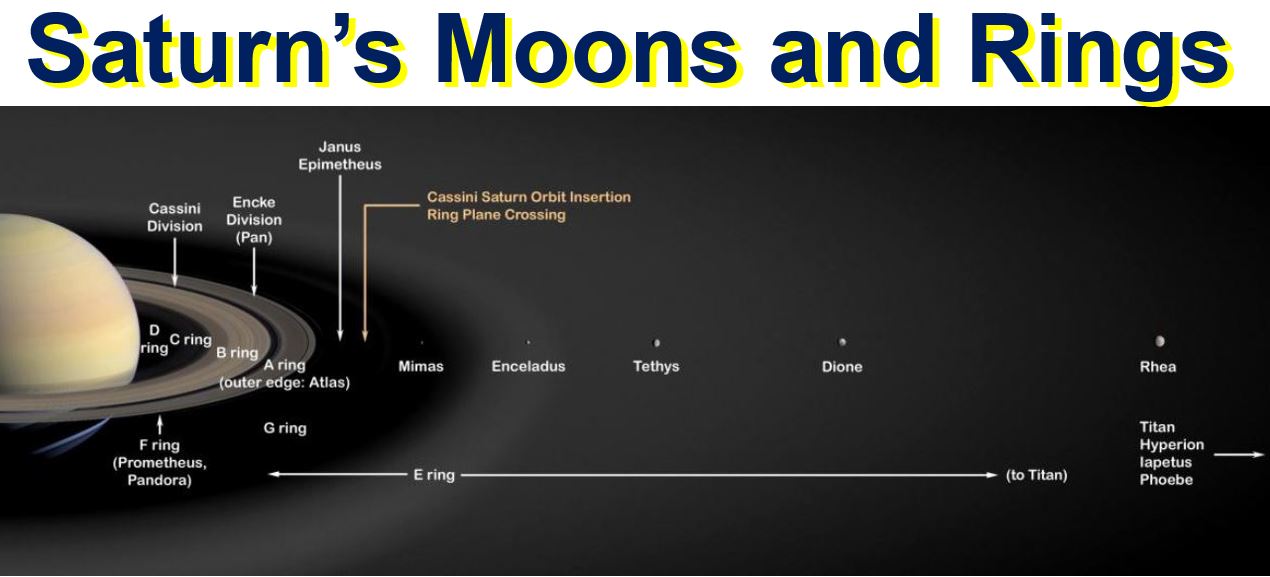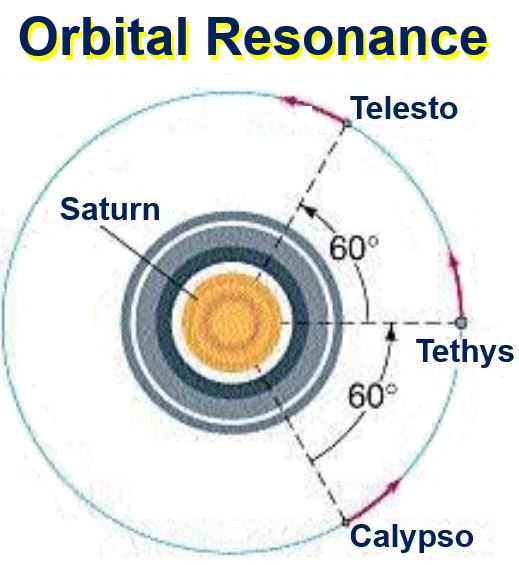Saturn has more than sixty moons and several extensive rings – the inner moons and rings may be very young, perhaps not even predating Earth’s dinosaurs, says a team of scientists. Saturn’s icy moons and its rings could well be a modern adornment just 100 million years old, which in the world of astronomy means they are mere infants.
Matija Cuk, principal investigator at the SETI Institute, and colleagues wrote about their latest study and findings in the Astrophysical Journal (citation below).
 Saturn’s moon Rhea and all other moons and rings closer to Saturn may be only 100 million years old. Outer satellites (not in picture), including Saturn’s largest moon Titan, are probably as old as the planet itself. (Image: seti.org. Credit:NASA/JPL)
Saturn’s moon Rhea and all other moons and rings closer to Saturn may be only 100 million years old. Outer satellites (not in picture), including Saturn’s largest moon Titan, are probably as old as the planet itself. (Image: seti.org. Credit:NASA/JPL)
Changing orbits helps estimate moon’s age
Dr. Cuk, who specializes in Solar System Dynamics, said:
“Moons are always changing their orbits. That’s inevitable. But that fact allows us to use computer simulations to tease out the history of Saturn’s inner moons. Doing so, we find that they were most likely born during the most recent two percent of the planet’s history.”
Scientists have known about Saturn’s rings since the 1600s. However, how old they are has long been debated. The simplest assumption is that they are primordial – as old as the planet itself is, i.e. over four billion years.
In 2012, however, French astronomers discovered that tidal effects – the gravitational interaction of the inner moons with fluids within Saturn’s interior – are driving them into wider orbits relatively quickly.
 The orbits of the moons Telesto and Calypso are tied to the motion of the moon Tethys. The combined gravitational pulls of Saturn and Tethys keep the small moons exactly 60° ahead and behind the larger moon at all times. (Image: staff.on.br)
The orbits of the moons Telesto and Calypso are tied to the motion of the moon Tethys. The combined gravitational pulls of Saturn and Tethys keep the small moons exactly 60° ahead and behind the larger moon at all times. (Image: staff.on.br)
This suggests that given their current positions, these moons, and presumably the rings too, are recent phenomena.
Dr. Cuk, together with David Nesvorny and Luke Dones, both from the Southwest Research Institute, used computer modelling to infer the past dynamic behaviour of the inner moons of Saturn.
Our own Moon, unlike those that orbit Saturn, does not have to share space with other celestial objects. All Saturn’s moons’ orbits slowly grow due to tidal effects, but not all at the same rates.
Saturn’s moons enter orbital resonances
Sometimes, pairs of Saturn moons enter so-called orbital resonances – a gravitational phenomenon in which two moons that orbit around one planet are in a specific pattern.
These happen when one moon’s orbital period is a simple fraction – e.g. ½ or ⅔ – of another moon’s period. In such special configurations, one moon’s gravity can strongly affect the orbit of another, making them more elongated and tilting them out of their original orbital plane. This can occur even when moons are small.
By comparing current orbital tilts with those predicted in their computer simulations, the scientists were able to learn how much the orbits of Saturn’s moons grew.
They discovered that for a number of the most important moons – Rhea, Dione and Tethys – the orbits are less dramatically altered than previously thought.
 Saturn’s equatorial diameter is 120,536 km, which is about 9.5 times bigger than that of the Earth. Saturn’s surface area is 83 times the area of Earth, and its volume is 764 times Earth’s. You could fit 764 Earths inside Saturn. Saturn’s mass is 95 times that of Earth. It is our Solar Systems 2nd largest planet (after Jupiter). (Image: nasa.gov)
Saturn’s equatorial diameter is 120,536 km, which is about 9.5 times bigger than that of the Earth. Saturn’s surface area is 83 times the area of Earth, and its volume is 764 times Earth’s. You could fit 764 Earths inside Saturn. Saturn’s mass is 95 times that of Earth. It is our Solar Systems 2nd largest planet (after Jupiter). (Image: nasa.gov)
Their relatively small orbital tilts suggest that they have not crossed many orbital resonances. This means they must have formed not far from where they currently are.
So, when were these moons born? Dr. Cuk and colleagues used the results of NASA’s Cassini mission to help find the answer to that question. The Cassini spacecraft has seen ice geysers on Enceladus, one of Saturn’s moons.
If we assume that the energy that powers these geysers comes directly from tidal interactions, and that Enceladus has a more-or-less constant level of geothermal activity, then the tides within Saturn are quite strong.
Inner moons born 100 million years ago
According to the researchers’ calculations, these would move the moon by the small amount indicated by the simulations in only approximately 100 million years. This would date the birth of the Saturn’s major moons, except for the more distant Titan and Iapetus, to the relatively recent Cretaceous Period, when the dinosaurs roamed the Earth.
Dr. Cuk said:
“So the question arises, what caused the recent birth of the inner moons? Our best guess is that Saturn had a similar collection of moons before, but their orbits were disturbed by a special kind of orbital resonance involving Saturn’s motion around the Sun.”
“Eventually, the orbits of neighboring moons crossed, and these objects collided. From this rubble, the present set of moons and rings formed.”
If this result is right, then Saturn’s rings could be younger than the peak of the dinosaur era, and we are lucky to witness them today, the scientists concluded.
In an Abstract in the journal, the authors wrote:
“We speculate that this disk has formed through orbital instability and massive collisions involving the previous generation of Saturn’s midsized moons.”
“We identify the solar evection resonance perturbing a pair of midsized moons as the most likely trigger of such an instability. This scenario implies that most craters on the moons interior to Titan must have been formed by planetocentric impactors.”
Citation: “DYNAMICAL EVIDENCE FOR A LATE FORMATION OF SATURN’S MOONS,” Matija Ćuk1, Luke Dones2, and David Nesvorný. The Astrophysical Journal, Volume 820, Number 2. 24 March 2016.
Video – Cassini Saturn Photos
This Wall Street Journal video contains 341,805 images taken by Cassini’s Imaging Science Subsystem – packed into 3 hours and 48 minutes.
